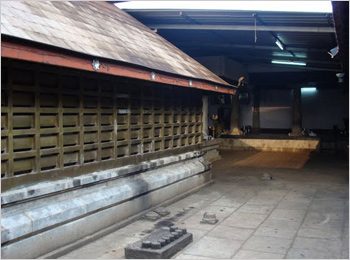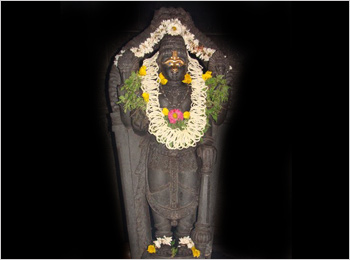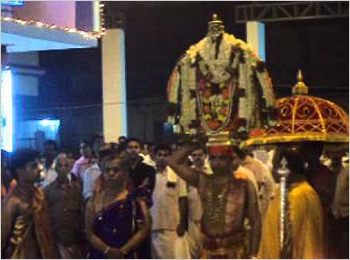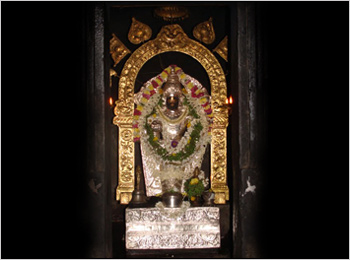- Vishnu
Adi Janardana Temple
- Shimanthur,Karnataka
- View on map
- Tell us about this temple
Overview
The Seemanthooru Janardana temple is a Lord Vishnu temple located in the Mangalore district of Karnataka. It is closer to Mulki. The name Seemanthooru is an offshoot of “Shrimantara Ooru” which means “land of the rich people!” Seemanthooru was indeed the land of the rich people.
About The Temple
The Seemanthooru Janardana temple was established by Bhagawan Parashurama. It is one of the several temples in the Tulu Nadu region that was established by Parashurama. According to Shastras, temple idols established by Rishis and Aparoksha Gnanis (realized souls) never get “damaged.” A few hundred years ago, the idol of Janardana was damaged. A few villagers got together and made a new idol and established the same, after which the temple and village declined. Upon enquiring with scholars, it emerged that the original idol still has the full Sannidhana and hence the problem. The idol was repaired and placed back. The original idol is now known as “Adi Janardana” and the new idol is also within the same temple. Hence this unique temple has two Janardana idols! Another unique feature of this temple is that it is one of the very few temples in Tulu Nadu that does not have a Ganapati idol! Seemanthooru Janardana is the “Akhilanda Koti Brahmanda Nayaka” and hence there is no other idol! But several Vishnu temples in Tulu Nadu do have Ganapati idols and hence Seemanthooru is really different.
About The Deity

Janardana is a name of Vishnu and appears as the 126th name in the ‘Vishnu Sahasranama’. According to Adi Sankara' s commentary on the ‘Vishnu Sahasranama’, translated by Swami Tapasyananda, Janardana means “One who inflicts suffering on evil men.” Alternatively, it means, “He to whom all devotees pray for worldly success and liberation.” Sri Adi Janardana temple at Shimantooru – like in several other Janardana temples (the one at Ambalpady, for example) – the image of the Lord does not hold a padma in his lower right hand. Instead of a lotus he holds a pinda, a rice ball of the kind used in shraddha rituals. The significance is obvious. Pindas, or rice balls, form an important element in the performance of shraddhas. A pinda represents the human body. It is made from anna, cooked rice, just as the human body grows from the food we eat. In the shraddha ritual, the performer lovingly shapes and makes pindas from well-cooked rice as temporary bodies for his forefathers to come down from swarga and occupy, and receive his offerings of arghya, padya, etc. After the ritual is over, and the forefathers go back to swarga, the visarjana of the pindas is done (just as is done in the case of clay images of deities after the poojas are over) in a body of water - a tank, a lake, a river or the sea.
Western philosophy speaks of macrocosm and microcosm. Macrocosm is the universe, and the human body is the microcosm – an epitome of the whole universe in miniature. The Indian words for them are brahmanda and pindanda. Our bodies – our pindandas – are given to us by the Lord, who has also created the brahmanda. He gave us our bodies, and our lives, so that we could perform our karmas. Our ancestors too had their role in the creation of our bodies: we all have genetic traits that come from our ancestors. So Janardana holds a pinda in his hand to show us, firstly, that He gave us our bodies, and secondly that He is the one who presides over all rituals connected with ancestral worship. So He is the one we must pray to, for our physical, mental and spiritual health; for connecting us with our forefathers; and to keep our family tree growing and prosperous.
Legend and Stories

Mythology tells us that Lord Parashurama himself founded the temple and installed the image of Janardana. He wrested the entire Western coast – the land west of Sahyadri from Gokarna to Kanyakumari – from the sea. He stood on a peak of Sahyadri, threw his battle axe into the sea and asked the sea to withdraw from the land up to the point where his axe fell. The sea obediently receded. The land thus reclaimed came to be known as Parashurama Kshetra. Parashurama built several temples in this reclaimed land, and the temple at Shimantooru is believed to be one of them.
A book called ‘Grama Paddhati’ tells us that the Kadamba king Mayuravarma brought Brahmins of several Gotras from the north and settled them in thirty-two villages of Tulunadu to perform poojas and other rituals in temples. Those who came to Shimantooru were of Kashyapa gotra. Their family names were Seemantooraya, shibarooraya, Asarannaya, Munnooraya, Mucchantaya, Madikulaya, Sedikulaya and Perannaya. These families have left Shimantooru and settled down in different parts of the country, and even abroad. But their Kula devata is Adi Janardana – though some of them may not know it as they, after leaving Tulunadu, have dropped their Tulu family names and adopted surnames like Rao, Acharya and so on.
Festivals
Annual festival: For 6 days starting Kumbha Masa Saptami (late February – early March)
Nearby Places to Visit

- Kateel Shree Shree Durgaparameshwari Temple,KATEEL(7 Kms)
- Bappanadu Shri Durgaparameshwari(3 Kms)
- Punaroor Shri Vishwanatha Temple, Punaroor(2 Kms)
- Thokur Shree Subramanya Temple, Thokur(3 Kms)
- Mundkur Shree Durgaparameshwari Temple(22 Kms)
- Padubidri Shri Mahalingeshwara Maha Ganapathi Temple, Padubidri(5 Kms)
- Pavanje Shri Mahalingeshwara Temple, Pavanje(5 Kms)
- Yermal Shri Lakshmi Janardana Temple, Yermal(8 Kms)
Accessibility
The Nearest Airport is Mangalore International Airport. The Nearest Railway Station is Mulki Railway Station (2 Kms). From Mangalore, reach Mulki using the Udupi highway and then turn right towards Kinnigoli. About 2kms later, you will find a temple arch. Turn left and travel 1km.
Temple Address
Shree Adi Janardana Temple,
Shimanthoor Post, Mulki, Mangalore,
Dakshina Kannada, Karnataka, India,
Pincode - 574 154.
Significance
Devotees visit this temple to seek fulfillment of the following:-
- Fame
- Freedom from diseases
- Wealth
- Courage
- Relief from adverse effects from bad planetary aspects
- Relief from bondage
Shlokas
Achutham Keyshavam Rama Narayanam Krishna Damodaram Vasudevam Harim Shridharam Madhavam Gopika Vallabham Janaki Nayakam Ramachandram Bhajey
Meaning -Oh Lord who cannot be perished, who also has names like Keshava, Rama, Damodara, Narayana, Sridhara, Madhava, Krishna, Ramachandra the beloved of Janaki, let me say your name regularly.
Vasudeva Sutham Devam Kamsa Chanoora Mardhanam Devaki Paramanandham Krishnam Vande Jagathgurum
Meaning -I bow to you O Krishna, the ultimate guru, Devaki and Vasudeva's son, and the destroyer of Kamsa and Chanur.
Adharam Madhuram Vadanam Madhuram Nayanam Madhuram Hasitam Madhuram Hridayam Madhuram Gamanam Madhuram Mathuraa Dhipate Rakhilam Madhuram
Meaning -Meaning - Sweet are Your lips, sweet is Your face, sweet are Your eyes, sweet is Your smile, sweet is Your heart, sweet is Your gait, O Lord of Mathura, everything about You is sweet.
Alokya Mathur Mukha Madarena Sthanyam Pibantham Saraseeruhaksham Sachinmayam Devam Anantha Roopam Balam Mukundam Manasa Smarami
Meaning -I think of this Balamukundan as the one who looks lovingly at his mother's face while taking milk from her, who has eyes similar to the red lotus, who is the embodiment of truth and intelligence and other forms.
Timings
The Temple is open from 09:00 am and 08:00 pm.
